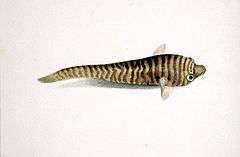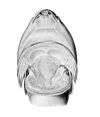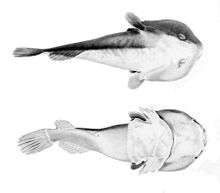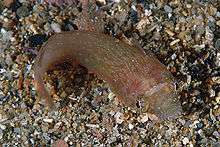Gobiesocidae
| Clingfishes | |
|---|---|
 | |
| Aspasmogaster tasmaniensis | |
| Scientific classification | |
| Kingdom: | Animalia |
| Phylum: | Chordata |
| Class: | Actinopterygii |
| Superorder: | Acanthopterygii |
| Order: | Gobiesociformes |
| Family: | Gobiesocidae Bleeker, 1860 |
Clingfishes are fishes of the family Gobiesocidae, belonging to the order Gobiesociformes. They are widespread throughout tropical and warm temperate waters, particularly in the marine waters of the Atlantic, Pacific and Indian Oceans. Most species shelter in shallow seagrass beds and reefs, clinging to rocks, algae and seagrass leaves.[1] Some species shelter in sea urchins or crinoids, or cling onto the bodies of larger fish.[1]
Description

Clingfishes are typically small fish, with most species less than 7 cm (2.8 in) in length.[2] A few species surpass this and the largest, Chorisochismus dentex, reaches up to 30 cm (12 in).[3] They have tapering bodies with single dorsal fins, and flattened heads. In most species, their pelvic fins are modified into a sucking disc.[2] The lateral line is well developed, but may not extend to the posterior parts of the body.
The skin of clingfishes is smooth and scaleless, with a thick layer of protective mucus. They have a cryptic colouration, and in some cases can rapidly change colour to match their background.[4]
Classification
The classification of the clingfishes varies. FishBase places Gobiesocidae as the only family in the order Gobiesociformes, under the superorder Paracanthopterygii;[5] whereas more official classifications within the United States, for example ITIS, place them in the suborder Gobiesocoidei of the order Perciformes, under superorder Acanthopterygii. ITIS lists Gobiesociformes as invalid and has been verified by the standards set forth by ITIS.[6][7]
Subfamilies and genera


Subfamily Cheilobranchinae
Subfamily Gobiesocinae
- Acyrtops
- Acyrtus
- Apletodon
- Arcos
- Aspasma
- Aspasmichthys
- Aspasmodes
- Aspasmogaster
- Briggsia
- Chorisochismus
- Cochleoceps
- Conidens
- Creocele
- Dellichthys
- Derilissus
- Diademichthys
- Diplecogaster
- Diplocrepis
- Discotrema
- Eckloniaichthys
- Gastrocyathus
- Gastrocymba
- Gastroscyphus
- Gobiesox
- Gouania
- Gymnoscyphus
- Haplocylix
- Kopua
- Lecanogaster
- Lepadichthys
- Lepadogaster
- Liobranchia
- Lissonanchus
- Modicus
- Opeatogenys
- Parvicrepis
- Pherallodichthys
- Pherallodiscus
- Pherallodus
- Posidonichthys
- Propherallodus
- Rimicola
- Sicyases
- Tomicodon
- Trachelochismus
- Unguitrema [8]
Subfamily Protogobiesocinae
References
- 1 2 Bray, Dianne. "Family GOBIESOCIDAE". Fishes of Australia. Retrieved 29 September 2014.
- 1 2 Froese, Rainer, and Daniel Pauly, eds. (2012). "Gobiesocidae" in FishBase. October 2012 version.
- ↑ Lubke, R., & I. De Mour (1998). Field Guide to the Eastern and Southern Cape Coasts. ISBN 978-1919713038
- ↑ Briggs, J.C.; Hutchins, J.B. (1998). Paxton, J.R.; Eschmeyer, W.N., eds. Encyclopedia of Fishes. San Diego: Academic Press. pp. 142–143. ISBN 978-0-12-547665-2.
- ↑ Froese, Rainer, and Daniel Pauly, eds. (2012). "Gobiesociformes" in FishBase. october 2012 version.
- ↑ "Gobiesociformes". Integrated Taxonomic Information System. Retrieved 5 February 2008.
- ↑ Standards
- ↑ Fricke, R. (2014). "Unguitrema nigrum, a new genus and species of clingfish (Teleostei: Gobiesocidae) from Madang, Papua New Guinea" (PDF). Journal of the Ocean Science Foundation. 13: 35–42.
- ↑ Fricke, R., Chen, J.-N. & Chen, W.-J. (2016): New case of lateral asymmetry in fishes: A new subfamily, genus and species of deep water clingfishes from Papua New Guinea, western Pacific Ocean. Comptes Rendus Biologies, 340 (1): 47–62.
External links
- Smith, J.L.B. 1964. The clingfishes of the Western Indian Ocean and the Red Sea. Ichthyological Bulletin; No. 30. Department of Ichthyology, Rhodes University, Grahamstown, South Africa.
| Wikimedia Commons has media related to Gobiesocidae. |
